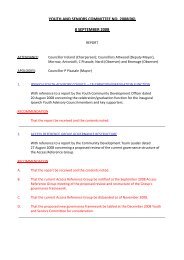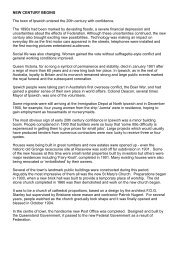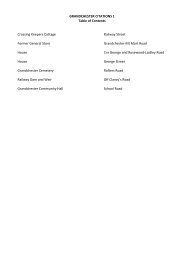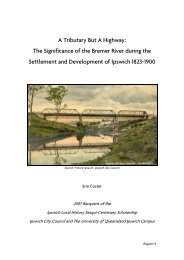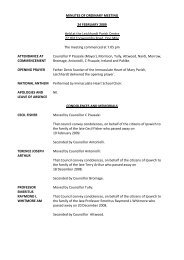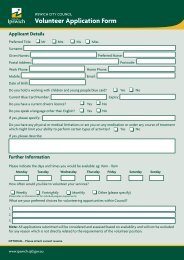TARRA GINDI TASSERONE - Ipswich City Council
TARRA GINDI TASSERONE - Ipswich City Council
TARRA GINDI TASSERONE - Ipswich City Council
You also want an ePaper? Increase the reach of your titles
YUMPU automatically turns print PDFs into web optimized ePapers that Google loves.
<strong>TARRA</strong> <strong>GINDI</strong> <strong>TASSERONE</strong>
Tarra is the man on the left hand side of the photograph.<br />
The other two men are supposed to be Mr Smith (Salvation Army) and Charlie Gorman from Tonga.<br />
Tarra was a South Sea Islander from the Loyalty Islands who worked for Mr and Mrs<br />
Alfred Foote of Quarry Street, <strong>Ipswich</strong>.<br />
Tarra was a prominent member of the Salvation Army in <strong>Ipswich</strong> for 25 years, most of<br />
it as the standard bearer.<br />
“Alfred Foote saw Tarra sitting on the roadside and “took him under his wing”. Tarra<br />
went to live with the Footes in Quarry Street, <strong>Ipswich</strong>. He was a friendly and well‐liked<br />
man who loved children.<br />
Mrs Dorothy Payne who lived for a while with her grandmother Mrs Foote,<br />
remembered that Tarra drove them and neighbouring children to <strong>Ipswich</strong> Central<br />
School in a horse‐drawn vehicle (the horse was named Charlie).<br />
Another grand‐daughter, Mrs Estelle Kahler remembered that Tarra always had jelly<br />
beans to give the children. When holidaying with the family at Southport, he would<br />
row them across to Main Beach (no bridge then).<br />
Viva said she was told that when land was being cleared for a new house in Brisbane of<br />
Mr and Mrs W.D. Grimes (Mrs Grimes was a Cribb) they asked Tarra what they should<br />
call the house and he said “Tarra Gindi”.
Source: Picture Queensland, SLQ ‐ Negative number: 196052. Foote family gathering at Land's End,<br />
Southport, 1905. Members of Alfred William Foote family showing his widow Eliza Ann with some of her<br />
children and their families. The children and some of the adults are displaying shells and found objects.<br />
On the back row, third from the end is the Kanaka, Tarragindi. He was blackbirded from the islands to<br />
work in the cane fields in Queensland.<br />
Mrs Payne and Mrs Kahler had a pet parrot which got loose. Tarra climbed a tree to<br />
recover it and fell. He injured his hip, complications set in and he died in the <strong>Ipswich</strong><br />
Hospital” 1 .<br />
Tarra died on 13 January 1913 and was buried on the 14 January 1913 in the<br />
Congregational Section of the <strong>Ipswich</strong> General Cemetery. The undertaker was J W<br />
Reed.<br />
Death of Tarragindi<br />
“A familiar figure in the city, largely because of his long and faithful association with<br />
the local corps of the Salvation Army, will be seen no more in his accustomed place in<br />
the ranks, or at the door of the barracks of that organisation. We refer to the kanaka<br />
Tarragindi. For some time past he had been an inmate of the <strong>Ipswich</strong> General Hospital,<br />
where, about 9 a.m. yesterday he breathed his last. Several months ago he had the<br />
misfortune to fall from a tree, with the result that he sustained a severe injury to one<br />
of his hips. Since then other complications set in, the result, doubtless, of advancing<br />
1 Family reminiscences provided to Robyn Buchanan by Ms Viva Cribb
years. Although is exact age is not known, it is believed that he was considerably over<br />
60 years old. He is one of the very few Pacific Islanders who came to this district in the<br />
early days of State and who have survived in Queensland till 1913. He was for many<br />
years in his earlier days engaged in different parts of the <strong>Ipswich</strong> district, but,<br />
practically for the last quarter of a century or more he has been employed by Mrs.<br />
Alfred Foote of Quarry Street. ‘Tara,’ as he was familiarly called, was never able to<br />
express himself in English with that facility which some of his fellow‐islanders’ could.<br />
Nevertheless, by his quaint sayings and his peculiar gestures he generally managed to<br />
make himself understood. He was naturally good tempered, and when subjected to<br />
‘chaff’ – which he had frequently to put up with – he treated it with a characteristic<br />
smile. Practically from the inception of the Salvation Army in <strong>Ipswich</strong> he had been a<br />
member of the organization, and in the course of his years of service he filled many<br />
positions. He was drummer, door‐keeper, and, for a very long time, standard‐bearer.<br />
Night after night he was to be seen bearing the flag at the head of the army as the<br />
soldiers marched along the streets of the city en route to the barracks. The funeral is<br />
to take place at 3.30 p.m. to‐day” 2 .<br />
The Last of Tarragindi<br />
“The mortal remains of the kanaka Tarraginidi, whose death was referred to in<br />
yesterday’s issue, were laid to rest in the <strong>Ipswich</strong> cemetery yesterday afternoon. As a<br />
mark of respect to the deceased, who has been a faithful soldier of the Salvation Army<br />
for the last quarter of a century, the flag at the barracks of that organization in<br />
Nicholas‐street was flying throughout the day. A special Army service was conducted<br />
in the hall at 3 p.m. The casket containing the body of the departed was placed in<br />
front of the platform. The reading‐desk was draped in white, and the drum was<br />
muffled in a cloth of the same colour, whilst each<br />
member of the corps, who were present strong<br />
force, wore a white band round the right arm. The<br />
bandsmen and a number of the members occupied<br />
the platform, whilst others sat in the body of the<br />
hall, where also assembled quite a large gathering<br />
of citizens who are not active members of the<br />
organization. The latter included about a score of<br />
the members of the Star of <strong>Ipswich</strong> Lodge, L.O.G.T.<br />
(of which society the deceased had been a<br />
member), who wore their regalia. The Chief<br />
Templar (Bro. Arnold Thomas) was amongst the<br />
number. Ensign Stowe (with whom was Lieut.<br />
Brown) conduced the service. Devotional<br />
exercises having been engaged in, several brethren<br />
bore testimony to the departed soldier’s faithful<br />
service whilst in the ranks of the Army. A brief<br />
appropriate address was delivered by the Ensign,<br />
who said that there was no reason to doubt that<br />
2 Death of Tarragindi, Queensland Times 14 January 1913, p.4.
their departed comrade had been ‘promoted to glory’. In accordance with a wish<br />
expressed some time ago by the deceased, the bank played ‘God be with You Till We<br />
Meet Again.’ The coffin having been conveyed to the hearse in front of the barracks,<br />
the funeral cortege moved by way of Nicholas and Brisbane Streets to the cemetery.<br />
The hearse was preceded by members of the Army, of the I.O.G.T. Lodge, and of the<br />
band, and, following it, was quite a large contingent of vehicles, each containing a<br />
complement of occupants. The service at the grave‐side was conducted by the Army<br />
officers” 3<br />
3 Queensland Times, 15 January 1913 p.4



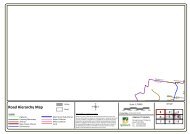
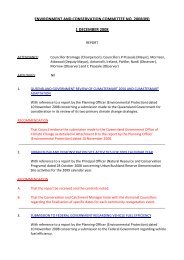

![Historic Homes tell a story [Read-Only] - Ipswich City Council](https://img.yumpu.com/23496138/1/190x146/historic-homes-tell-a-story-read-only-ipswich-city-council.jpg?quality=85)

